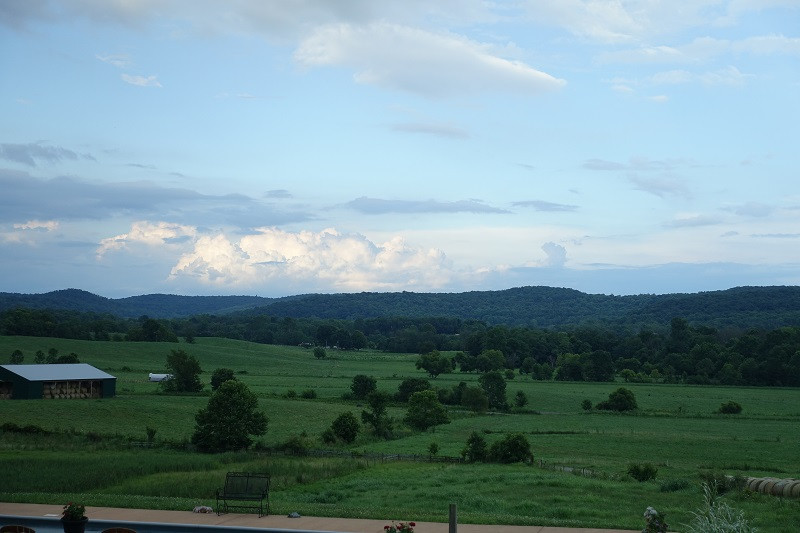Cloudscape
posted on
July 19, 2019

We are discovering clouds, and marvel at all they witness.
Our new house offers a panoramic view of clouds, almost like being near the ocean. We are starting to learn basic formations, such as cumulus, stratus, and cirrus. Cumulus is puffy and soft looking; stratus is thick and dense, like fog; cirrus is wispy, like a horse's tail. The story offered by clouds is always changing, as if gods in heavens are improvising the narrative, as in a jazz ensemble. The world of nature offers so much to observe, and clouds are one of its wonders.
Given their vantage point, they witness all! So, what have they observed on this farm over the past two weeks?
We finally filled the Hay Barn with hay. That feels good, as hay left outside deteriorates, especially given the amount of rain we have had over the past several years. A remaining imminent step is to enclose the west side of the barn, from which direct weather comes.

We harvested another batch of pastured chickens, and continue to be impressed with how good the meat is, full of flavor and texture. They are moved to fresh grass daily, which makes all the difference. One can taste minerals in the meat.


We have treated several animals for pink eye, which arises in hot, wet conditions. One calf was so adversely affected, he couldn't see out of either eye. Clark found him mired in a drainage ditch marooned and apart from the herd. Clark was able to extract him with help of a lasso, which task was arduous. But the calf was vigorous enough not to allow the lasso to be removed. This kind of impairment happens so infrequently, we don't have a lot of experience with it and weren't sure what to do next. The following day, however, we gave him a shot of antibiotics in the field via a specially designed air pistol. We hadn't used the air pistol in 3 years, as we hardly ever have to implement this tactic. But it was clear, we had to act, or this otherwise good-looking calf would suffer and die out in the field. By this time, the rest of the herd had been moved to a different pasture. It is difficult to direct a solo 400-lb calf in any direction without its mother, especially when it can't see. It was a concern as to what we would do next with this calf. Clark checked on the calf the following day. The lasso was still around its neck, and the calf was seeing better. In fact, he wanted to move, so Clark grabbed the trailing rope, and via pressure on the rope, and strategic presence behind and to the calf's side, was able to direct the calf across a field, through a narrow gateway, up a steep hill, down the other side, up and down a second hill, past the herd, across a bridge, along a lengthy laneway, up the hill to our barns, and into the holding pens. It was a hot day, and it took close to an hour for this unlikely journey to be completed. Both calf and handler were tired.
Clark acted at the perfect moment, when the calf was able to see just enough to move but not so much to become unmanageable. This rescue was an example of excellent stockmanship.
We now have the calf under roof, and in the shade, and the lasso has been removed. We gave him a second shot of antibiotics yesterday and today started an age-old treatment of flecking salt into the eye for a number of days. He is healing, and within a few more days, will be back on pasture with his comrades. Any animal that is treated with antibiotics is duly noted in our medical journal. The eartag is also notched, so we can tell at a glance the animal is to go to "town" rather than to our processor for our customers.
Job well-done, Clark.

We enjoyed a restful week in Ontario, with a few nephews and spouses. It is a privilege to listen to the younger generation make sense of the complex world we present to them. I slept more than normal, and Susan cooked, as normal. On the left is lamb shoulder, Greek salad, polenta, baked bananas, and fresh peas, with a portion saved for the bear-gods, who watch over us. On the right is Lake Trout from Lake Huron, accompanied by fresh fruit, corn, and another Greek salad. What manna, which the nephews truly appreciated.


May we behold the wonder of clouds and all they witness, without our vision becoming clouded!




